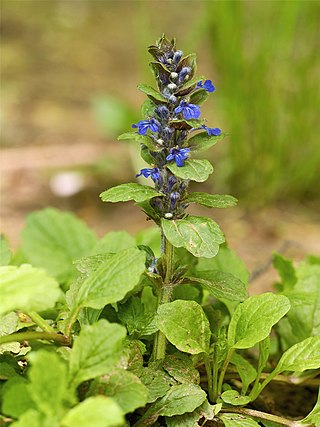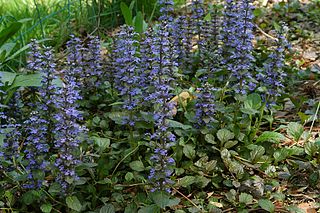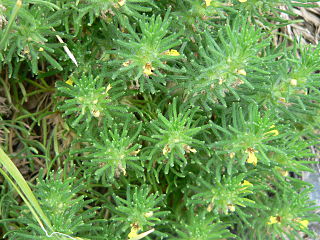The name bugleweed is a common name which can refer to several unrelated plants:
- Ajuga , especially
- Ajuga reptans , the most common species in the British Isles
- Lycopus , the genus to which the gypsywort belongs
The name bugleweed is a common name which can refer to several unrelated plants:
Sycamore is a name which has been applied to several types of trees, but with somewhat similar leaf forms. The name derives from the Ancient Greek σῡκόμορος meaning 'fig-mulberry'.
Gum tree is the common name of several trees and plants:

Reed is a common name for several tall, grass-like plants of wetlands.

Ajuga, also known as bugleweed, ground pine, carpet bugle, or just bugle, is a genus of flowering plants in the Ajugeae tribe of the mint family Lamiaceae. There are over 60 species of annual or perennial, mostly herbaceous plants. They are native to Europe, Asia, Africa, and Australia.
The bugle is a brass musical instrument.

The pearl-bordered fritillary is a butterfly of the family Nymphalidae found in Europe and through Russia across the Palearctic to the north of Kazakhstan.
Ground pine or ground-pine may refer to:

Ajuga reptans is commonly known as bugle, blue bugle, bugleherb, bugleweed, carpetweed, carpet bugleweed, and common bugle, and traditionally however less commonly as St. Lawrence plant. It is an herbaceous flowering plant in the mint family Lamiaceae, native to Europe. It is invasive in parts of North America. It is also a component of purple moor grass and rush pastures, a Biodiversity Action Plan habitat in the United Kingdom.
Carpetweed is a common name for several plants and may refer to:
Blue bugle is a common name for several plants and may refer to:
Clerodane diterpenes, sometimes referred to as clerodane diterpenoids, are a large group of secondary metabolites that have been isolated from several hundreds of different plant species, as well as fungi, bacteria and marine sponges. They are bicyclic terpenes that contain 20 carbons and a decalin core.

Ajuga pyramidalis, commonly known as pyramidal bugle, is a flowering plant of the genus Ajuga in the family Lamiaceae. It is a native plant in Europe.

Ajuga chamaepitys is a species of flowering plant of the family Lamiaceae. Popularly known as yellow bugle, Chian bugle or ground-pine, the plant has many of the same characteristics and properties as Ajuga reptans. A. chamaepitys can be found in Europe, the Eastern part of the Mediterranean, and North Africa.

A. genevensis is a herbaceous flowering plant native to Europe. It is less common than its relative, Ajuga reptans.
Blue bugleweed is a common name for several plants and may refer to:
A. salicifolia may refer to:

Ajuga australis, commonly known as Austral bugle, is a herbaceous flowering plant native to Eastern Australia. First described by Robert Brown, it is occasionally seen in horticulture.
A. pyramidalis may refer to:

Ajuga orientalis, also known as Oriental bugle and Eastern bugle, is a herbaceous flowering plant native to the Eastern Mediterranean. It is found in the sandy, dry brushwood and lightly forested regions of the coast. It is usually evergreen, although it may be briefly deciduous in cold winters.
Ajuga turkestanica is a herbaceous flowering plant native to Central Asia. It was first described in 1894.